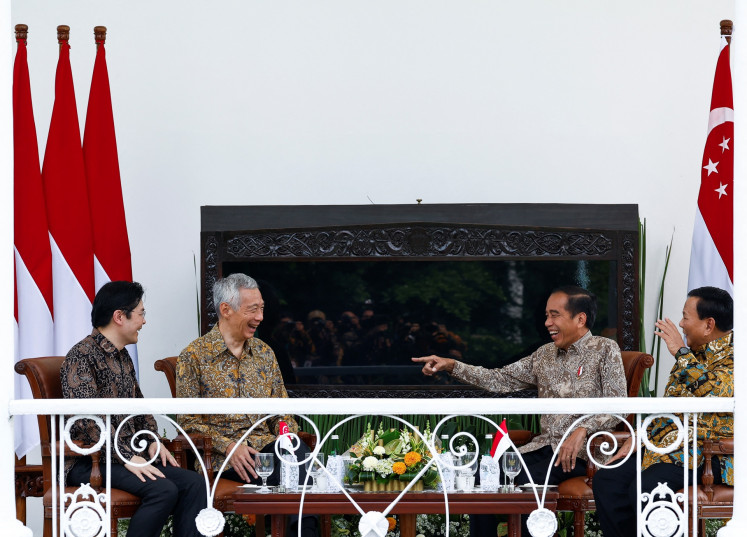Vertical gardens transform urban neighborhood
Green and ripe: A women harvests water spinach from a hydroponic installation in a neighborhood in Pengadegan, South Jakarta
Change Size

G
reen and ripe: A women harvests water spinach from a hydroponic installation in a neighborhood in Pengadegan, South Jakarta. (JP/Musthofid)
A small and densely populated neighborhood in South Jakarta has transformed itself from being unknown into becoming a world attraction, thanks to a hydroponic farming initiative.
The welcome sign, which reads Kampung Hidroponik, hangs over the entrance gate to a narrow but green alley, both sides adorned with green vegetables grown in installed pipes.
Across the houses, the vertical gardens have been put up against a perimeter wall and newly painted murals add color and brightness to the greenery.
The new look of the environment has been brought about by a hydroponic project in the Pengadegan subdistrict launched two years ago and jointly sponsored by Zurich Insurance, the International Federation of the Red Cross and its national affiliate.
“The wall used to be blackened, dirty and dilapidated,” Jenal, head of the 15-strong work team, told The Jakarta Post.
At the start of the project in August 2017, the neighborhood, which is home to 70 households, had four installations. There are now 13 installations containing a total of 1,780 planting holes.
Not only does the green environment gives a bit of fresh air amid the urban hustle and bustle, but the yields, among them spinach, water spinach, cabbage, lettuce and tomato, provide them with more hygienic produce.
Jenal says the harvesting cycle is between 25 and 30 months with the yield amounting to between five and eight kilograms of produce from four to 10 installations at every harvest.
Social life is also becoming more receptive with the people engaging each other more often.
“The work team consists of only 15 people but almost everyone here gets involved, particularly in helping keep the plants. And people are enthusiastic when it comes to harvesting the produce,” Jenal said.
Agricultural researcher Indarti Puji Lestari said she applauded the community activities in hydroponic cultivation, saying that if developed more extensively, the urban farming can help contribute to national food self-sufficiency.
“Farmers or community groups are cultivating hydroponics currently for their own consumption. However, the produce has helped curb their spending on vegetables,” Indarti, a researcher at the Agricultural Technology Assessment Center (BPTP) of Jakarta chapter, says.
“The hydroponic yields are hygienic, free of chemical pesticides,” she says.
BPTP, she says, is pushing ahead with its agenda to promote hydroponics among members of the public through training sessions, exhibitions, brochures and cooperation with the private sector.
Apart from BPTP’s efforts, hydroponic consultant Ronny Tanumihardja says the government generally lacks initiatives involving hydroponics.
While Indarti recalls she started her hydroponic research on tomatoes as early as 1990, Ronny says hydroponics in Indonesia first gained popularity only eight years ago, with the last four years seeing rapid development thanks to public and private initiatives
“For the most part, it is a social initiative, individually or in a community. The government’s role is very minimal. Very few city administrations have begun promoting urban farming, or specifically hydroponics. They combine them with conventional [farming],” Ronny says.
Ronny is an architect by profession but his newly discovered passion has left him juggling between drawing and gardening.
His CV has a longer list of training and consultation roles on hydroponics than on architecture.
He has pursued developing his hydroponics knowledge in Chiba, Japan, and founded Smart Hydroponics in 2016.
“I learned about plant factories and I have implemented in Indonesia,” Ronny says about his short course in Chiba University.
Plant factories are hailed to be the future of farming. Wintergreen Research, as reported on powerhousehydroponics.com, indicates that the plant factory market will be worth an estimated total of US$1.97 billion by 2020.
“We offer services in training and consultation on gardening, including the designs and installations,” he says.
“We carry out hydroponic activities for social causes at times, individually or in a community,” he says.
His urban farming passion may make him known more as a hydroponics practitioner than an architect, while the small neighborhood’s urban farming has attracted the world. Its visitors’ book includes names from the United States, Switzerland and South Korea.









